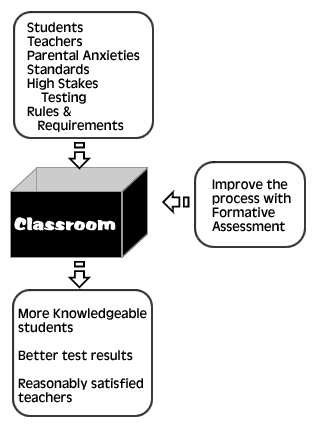- OU Homepage
- Search OU
- OU Social Media
- The University of Oklahoma
Inside the Black Box: Raising Standards Through Classroom Assessment

This KnowledgeBase archive includes content and external links that were accurate and relevant as of September 30, 2019.
In this 1998 article, Black and Wiliam present evidence pointing out the usefulness of formative assessment with raising the standards of classroom achievement. Since the focus on improving achievement lies in the classroom, they emphasize that formative assessment is the most effective tool for accomplishing such improvement.
In presenting their case for formative assessment, the authors start out with a black box analogy. In doing so, they suggest current approaches to improving achievement do not produce the desired results. Whatever is happening in the classroom (that black box) is affecting the output. The authors contend that teachers cannot be expected to make things better on their own. As they look inside this black box, Black and Wiliam see formative assessment as the tool that lies at "the heart of effective teaching." In the balance of the article, Black and Wiliam make their case for formative assessment addressing three questions.
"Is there evidence that improving formative assessment raises standards?
Is there evidence that there is room for improvement?
Is there evidence about how to improve formative assessment?"
In assessing whether there is evidence that formative assessment raises standards, the authors looked at past research studies. At the time of this article, they concluded the reviewed studies showed improved formative assessment helped lower achieving students more than other students.
Was there room for improvement with the application of formative assessment? Their answer was yes in regard to fostering effective learning, a focus on results rather than feedback, and managing the results.
To improve formative assessment, they "encouraged focusing on students' self-esteem, self-assessment by students and professional development for teachers blending together instruction with formative assessment and a refocusing of assessment policy and practice."
They conclude with advocating four steps to bring formative assessment to the forefront in the classroom.
- Learning from development. Teachers will not take up ideas that sound attractive, no matter how extensive the research base, if the ideas are presented as general principles that leave the task of translating them into everyday practice entirely up to the teachers.
- Dissemination. This dimension of the implementation would be in low gear at the outset -- offering schools no more than general encouragement and explanation of some of the relevant evidence that they might consider in light of their existing practices. Dissemination efforts would become more active as results and resources became available from the development program.
- Reducing obstacles. All features in the education system that actually obstruct the development of effective formative assessment should be examined to see how their negative effects can be reduced.
- Research. Although there are many and varied reports of successful innovations, they generally fail to give clear accounts of one or another of the important details. For example, they are often silent about the actual classroom methods used, the motivation and experience of the teachers, the nature of the tests used as measures of success, or the outlooks and expectations of the pupils involved.
To read the complete article, click on the source document.
Source:
Inside the Black Box: Raising Standards Through Classroom Assessment, Paul Black and Dylan Wiliam, PHI DELTA KAPPAN, 1998, Phi Delta Kappa International
About the authors - "PAUL BLACK is professor emeritus in the School of Education, King's College, London, where DYLAN WILIAM is head of school and professor of educational assessment."
The contents of this website were developed under a grant from the U.S. Department of Education and are intended for general reference purposes only. However, those contents do not necessarily represent the policy of the U.S. Department of Education or the Center, and you should not assume endorsement by the Federal Government. Some resources on this site require Adobe Acrobat Reader. This website archive includes content and external links that were accurate and relevant as of September 30, 2019.
